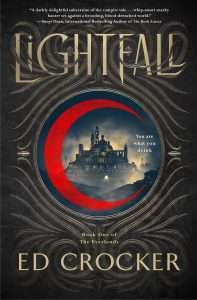Adrian Collins's Blog, page 37
November 7, 2024
REVIEW: Time’s Agent by Brenda Peynado
Last Updated on November 8, 2024
In Time’s Agent by Brenda Peynado (Tordotcom) humanity has discovered pocket worlds, tiny entry points into other worlds, sometimes a few kilometres square, other times barely large enough to fit a person. They hold beautiful opportunities to start over, find wondrous histories of small civilisations come and gone, discover and cultivate new flora and fauna, and to experience exploration like few in this modern era have done. It’s an opportunity for us to do better, but, we are humanity, and we are experts in ruining things.

Raquel and her wife Marlena work for The Institute, a scientific organisation on the bleeding edge of pocket world discovery. Pocket worlds run with time dilations, which can have some unintended consequences on time agent’s lives. When Raquel tries to help a woman who has just lost her son to a pocket world point, she breaks the rules and in a moment finds herself thrown forward in time from the excitement of her career and the rush of discovery, to a world where corporations have taken over from The Institute, commercialised pocket worlds, and her daughter has been killed in the ensuring war Raquel accidentally kicked off.
Time’s Agent is a novella I could not put down. The writing is just gorgeous throughout, delivering a story so layered in deep themes that I actually feel like I’ve imbibed a full-sized novel. Throughout this book, we delve into corporate greed, societal blind-spots, motherhood and loss, the impact of modern society on the spirituality of our history, time travel, relationships, and so much more. This is a novella for the awards lists, if I’ve ever read one. Peynado’s voice is on point, driving feelings of the weary excitement of discovery early on, and then going deep into the soul-crushing depression of late-stage capitalism, of a society eating itself alive for a dollar, that I would consider up there with T.R. Napper‘s cyberpunk voice.
What brings Time’s Agent truly to life, however, is not just the pocket worlds, or society’s decline–it’s the story of how Raquel and Marlena deal with the loss of their daughter. I really enjoyed the central story of what they had to go through to get what they wanted, and the way two people deal with what’s happened. I loved the message in there about understanding what you have, versus always striving for what you think you’re missing–something I think is quite poignant in our modern social-media driven society.
Time’s Agent by Brenda Peynado is warning shot to our modern species. It’s a lens into humanity’s ability to destroy the naturally beautiful for profit, to sequester that profit for the fortunate few while the rest slave to live, and a mirror to our society who collectively allow this to happen by participating, turning blind eyes, and only realising what we’ve done as a society once it’s too late to undo it. An absolutely harrowing must-read novella.
Read Time’s Agent by Brenda PeynadoThe post REVIEW: Time’s Agent by Brenda Peynado appeared first on Grimdark Magazine.
November 6, 2024
REVIEW: A Quiet Place: Day One
Third in the series and acting as a kind of prequel, A Quiet Place: Day One, directed by Michael Sarnoski, offers something thematically different to the previous films. Taking place on the first day of the alien invasion, this morphs from a muted, pessimistic mediation on what it means to live with terminal illness to a loud, high-energy action horror, to a life-affirming commentary on friendship and community. This is not what people were expecting from the franchise, and I can see why so many people were disappointed as result. However, taken on its own terms, this is an interesting character study, a deep, thoughtful look at what it means to live, especially when it’s all going to be taken away anyway (as it will be for us all, even without a cancer diagnosis), and is well worth watching for that alone.
 Still, unless you are a particularly loud person for whom the idea of being quiet long term produces a deep, existential dread, A Quiet Place: Day One is not going to be a film which frightens you all that much. Save a few jump scares and the notion that a wickedly fast and endlessly hungry alien race could land on Earth out of the blue and attempt to eat everyone, there’s not really that much to fear in terms of typical horror here. What you get instead is a film that makes you think about what it means to be human, what it takes to survive, and whether you could save your cat from being a predator’s lunch. As an aside, one of the best things to come out of A Quiet Place: Day One is the TikTok trend in which people attempted to run around their house with their cat(s) or dog(s) in an effort to see whether their pets could be quiet and therefore allow the whole family to survive… spoiler alert, most didn’t, including me and mine. That the cat is the real hero of the show surprises no-one and for those who agree that animal deaths are a dealbreaker even when the rest of the movie is knee deep in blood and gore, don’t worry, you’re good. Frodo the cat smashes it out of the park with his acting role and I’ve had a serious word with both of my own cats about their shocking lack of ambition when it comes to making Hollywood movies.
Still, unless you are a particularly loud person for whom the idea of being quiet long term produces a deep, existential dread, A Quiet Place: Day One is not going to be a film which frightens you all that much. Save a few jump scares and the notion that a wickedly fast and endlessly hungry alien race could land on Earth out of the blue and attempt to eat everyone, there’s not really that much to fear in terms of typical horror here. What you get instead is a film that makes you think about what it means to be human, what it takes to survive, and whether you could save your cat from being a predator’s lunch. As an aside, one of the best things to come out of A Quiet Place: Day One is the TikTok trend in which people attempted to run around their house with their cat(s) or dog(s) in an effort to see whether their pets could be quiet and therefore allow the whole family to survive… spoiler alert, most didn’t, including me and mine. That the cat is the real hero of the show surprises no-one and for those who agree that animal deaths are a dealbreaker even when the rest of the movie is knee deep in blood and gore, don’t worry, you’re good. Frodo the cat smashes it out of the park with his acting role and I’ve had a serious word with both of my own cats about their shocking lack of ambition when it comes to making Hollywood movies.
The human actors are just as effective – Luipta Nyong’o is great in everything she does, but she gives a kind of deep anger and despair to her role here. I would have gone straight to pissed – I already have terminal cancer and now I have to deal with this shit – but she takes her already bad hand and somehow grows under the pressure of the end of the world. She was nothing short of mesmerising and this played well against Joseph Quinn’s shell-shocked but quirky and humorous role. This nouveau family, brought together by the cat, struggle against the end of the world – and I’ll leave it to you to see who wins.
When it comes to cinematography in A Quiet Place: Day One, some of the close up scenes had that slightly fuzzy look where the CGI becomes very clear against the much sharper background or actor, but there’s a thrilling number of aliens and there are some effective scenes of them rampaging round like cats during 3am zoomies. Even so, my preference is always for the horror unseen and this film excels in the first moments of contact, when there’s destruction and screaming and people being ripped away into the dust and darkness by creatures unknown and only slightly glimpsed. There’s something deliciously appealing about watching the very human reactions to shock and trauma – shouting, crying, screaming – turned against them by creatures with an ear for the slightest sound.
Certainly, there are lots of positives to be found in A Quiet Place: Day One, especially if you go in without expectations of seeing exactly what you’ve seen before in the first two instalments. Perhaps that, in itself, could be a criticism – this is not really a horror, after all. But there’s some excellent acting, lots of people die horribly, and a cat. What more do you need?
Watch A Quiet Place: Day OneThe post REVIEW: A Quiet Place: Day One appeared first on Grimdark Magazine.
November 5, 2024
REVIEW: The Way Up is Death by Dan Hanks
If you thought Stephen King had conjured up the weirdest and darkest tower in existence, then Dan Hanks is here to prove you wrong in The Way Up is Death. In turns brutally disturbing, hysterically funny and soul-stirringly poignant, this extraordinarily bizarre acid trip of a survival adventure will melt your brain and crush your soul without remorse, and I love it all the more for it.
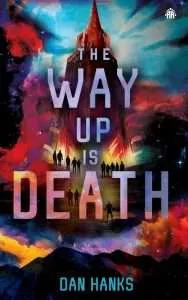 What would you do if one day, out of nowhere, you are mercilessly pulled out of your daily life and dropped along with 12 other strangers before a mysterious floating tower that demands you ASCEND. That, my friends, is just a tiny glimpse of the stupendously intriguing premise of The Way Up is Death. And as you can maybe guess from the title, it doesn’t take long for things to get disturbingly dark and absolutely batshit crazy in the best way possible.
What would you do if one day, out of nowhere, you are mercilessly pulled out of your daily life and dropped along with 12 other strangers before a mysterious floating tower that demands you ASCEND. That, my friends, is just a tiny glimpse of the stupendously intriguing premise of The Way Up is Death. And as you can maybe guess from the title, it doesn’t take long for things to get disturbingly dark and absolutely batshit crazy in the best way possible.
Through the eyes of Alden, a lonely and grief-stricken teacher by day/singer by night, Nia, a weary and angry concept artist, and Dirk, a self-obsessed walking red flag of a celebrity children’s author, we get to experience the nightmarish madness contained within the tower from the front-row seat. While I sometimes had a hard time visualising the increasingly weird and mystifying settings that the tower contained, I never felt lost because these characters’ strong voices kept me so grounded throughout all the madness. Their virtues and vices are truly on full display (for better or worse; looking at you, Dirk), and I loved exploring how they each reacted in such an authentically unique way to the horrors that they were faced with over the course of the single day that they spend in this tower of terror (if they even make it that long).
See, on the surface this story might seem like just another brutal thrill fest of a race against death, but at its core it’s a deeply emotional and beautifully human story that just tugged on my heartstrings in all the most unexpected ways. The Way Up is Death is honestly more multi-layered than the twisted labyrinthine tower it’s set in, and I loved how with each new level the characters ascended, another layer of complexity and emotional depth was peeled back. Heavy themes such as grief, sexism, female rage, loneliness, sacrifice, morality, memory, love, humanity, and, naturally, mortality are all explored in surprisingly deep though often darkly entertaining ways without ever detracting from the addictive thrill factor of the narrative, which is exactly what makes this story stand out from the crowd to me.
Now, I do have to admit that I found some of the (side) characters to be little more than obvious cannon fodder or a mere vessel for the theme they were supposed to represent, which not only made some of the thematic messaging feel a bit on the nose, but also took away some of the stakes and unpredictability of the story for me. The slightly caricaturish character work combined with the break-neck speed pacing somewhat hindered my emotional investment in the wider cast of characters, and that ultimately made some of the supposedly hard-hitting moments fall a bit flat for me.
However, the key characters of the narrative absolutely carried the story for me (Rakie is the MVP, just saying), and I can’t deny that all the emotional gut punches just hurt oh so good in the end. For the longest time I was just along for the crazy ride, uncertain if or how we would get any satisfying answers to the deeper purpose behind the inexplicable mysteries and challenges of the tower, but Hanks managed to surprise me in all the best (or worst?) ways with the shocking revelations. The brutally bittersweet conclusion to The Way Up is Death was more satisfying than I could ever have hoped for, leaving me with only one big unresolved mystery in the end: how in the hell did Hanks manage to write a story that is simultaneously so bizarrely alien yet beautifully and relatably human?
Regardless of what your typical reading preferences are, The Way Up is Death is guaranteed to lure you in with its dangerously addictive storytelling, darkly alluring mysteries, visceral emotions, and scarily evocative imagery that will haunt your mind for days and nights to come. It’s got a bit of fantasy, sci-fi, horror, mystery, thriller, and arguably even a sick and twisted version of LitRPG, but ultimately it’s a powerfully moving and truly transcendental story that just speaks to the soul and showcases the incredible resilience of the human spirit. This is one of those stories that you simply can’t do justice to in a review, so please do yourself a favour and go experience its brilliant madness for yourself, if you dare.
Thank you to NetGalley and Angry Robot Books for providing me with an eARC in exchange for an honest review. All opinions are my own. The Way Up is Death is scheduled for release on January 14, 2025.
Read The Way Up is Death by Dan HanksThe post REVIEW: The Way Up is Death by Dan Hanks appeared first on Grimdark Magazine.
November 4, 2024
REVIEW: V for Vendetta
Remember, remember the fifth of November. It’s time for your annual rewatch of V for Vendetta. Oh, wait, no, that’s just my version. Watching V for Vendetta has been my little Fifth of November tradition since the early 2000s. It occurs to me, like the Alan Moore comic of the same name, that the V for Vendetta movie ticks many boxes of things grimdark fans may enjoy. If you haven’t picked up this graphic novel or watched the film, I humbly suggest them for your autumn reading pile or a movie night.
 For those who don’t know, the rhyme is ‘Remember, remember, the fifth of November—gunpowder, treason, and plot. I see no reason why gunpowder treason should ever be forgot.’ It commemorates the Gunpowder Plot when, in 1605, Guy Fawkes and his conspirators attempted to blow up the House of Lords and the King on that fateful fifth of November night.
For those who don’t know, the rhyme is ‘Remember, remember, the fifth of November—gunpowder, treason, and plot. I see no reason why gunpowder treason should ever be forgot.’ It commemorates the Gunpowder Plot when, in 1605, Guy Fawkes and his conspirators attempted to blow up the House of Lords and the King on that fateful fifth of November night.
As a brief history lesson, and because it is pretty grim and dark, we Brits burn effigies of poor old Guy on a bonfire each the fifth of November (and let off fireworks terrifying the local four-legged residents) but Mr. Fawkes wasn’t burnt at the stake as this method of execution was only used for women. Lucky us. Instead, Guy was sentenced to be hung, drawn, and quartered, where he would have been hung until nearly dead, then taken down from the gallows, emasculated, disembowelled, beheaded and then hacked into four chunks. Supposedly, Guy “accidentally” died during the hanging part of this torturous execution, but still. Awful.
V for Vendetta opens with the voice-over of this rhyme and a brief historical recap, with Evey Hammond, the movie’s leading lady played by Natalie Portman, pointing out that everyone remembers this rhyme, this idea of revolution, and the name of Guy Fawkes as a revolutionary, but no one remembers him as a man. This is an idea that will reoccur throughout the movie.
Set in a dystopian near future, V for Vendetta has a far-right totalitarian government. Movements are restricted, food and water are rationed, and state-controlled media churns out propaganda to the masses. In addition to leading lady Evey Hammond, the main man is V, played to perfection by Hugo Weaving. V is a masked vigilante with a violent vendetta. Like his historical inspiration, V plans to blow up parliament on the fifth of November as a catalyst for change.
Although not entirely like the graphic novel that inspired it (movie V is more of a romantic freedom fighter than a ruthless anarchist, and Evey’s traumatic life and more traumatic transformation are toned down for film watchers), V for Vendetta is a better adaptation than some of Moore’s other graphic novels which have been treated to a movie makeover. It may have been the Thatcher era that inspired Moore, but even now, nearly 20 years after the film was released, the fictional Britain portrayed here doesn’t feel like it is an entirely unrealistic scenario. That thought alone is enough to give a slight pause while watching.
With a screenplay by the Wachowski siblings and the directorial debut of James McTeigue, who was their assistant director on The Matrix, it is unsurprising that, at times, the audience can see style parallels between The Matrix and V for Vendetta. The final fight scene of the movie is particularly reminiscent of this, but it still stands out to me as one of the film’s memorable moments.
The casting is my favourite part of V for Vendetta, except for Natalie Portman’s questionable British accent. Hugo Weaving is a magnetic screen presence, and I still remember the awe with which I watched him on the big screen as V all those years ago. We never see his face in any of the guises in which he appears, and with only his voice and physical presence, Weaving steals every scene he is in. Some stellar actors are in supporting roles too, including John Hurt as Chancellor Sutcliffe, Stephen Fry as gay TV executive Gordon Dietrich, and Stephen Rea and Rupert Graves as disillusioned police officers investigating V.
V may have been turned into the unlikely hero of the film adaptation of V for Vendetta, but he still has some questionable morals. Lines like “violence can be used for good” and torturing one of the people closest to him still suggest that the ends always justify the means here. Speaking of which, the ending of V for Vendetta, where parliament explodes to classical music, and the hundreds of “V” s unmask themselves to reveal the victims of the corrupt government, is another of the many visually remarkable moments in the film.
As with almost all adaptations, part of me wants to point out that Moore’s graphic novel is “better” than McTeigue’s version of V for Vendetta, but as this is one of my favourite films, I shan’t do that too loudly. Every rewatch, I pick up on something different (I haven’t even had a chance to touch on the Valerie sub-plot and its portrayal here), and the fact that the film still feels entertaining, relevant, and politically significant today should speak volumes about the standard of V for Vendetta.
Watch V for VendettaThe post REVIEW: V for Vendetta appeared first on Grimdark Magazine.
November 3, 2024
REVIEW: The Book That Held Her Heart by Mark Lawrence
Last Updated on November 4, 2024
The feeling of emotional devastation lingers long after closing the back cover of Mark Lawrence’s The Book That Held Her Heart, the final volume of his mind-bending Library Trilogy, which began with the highly acclaimed The Book That Wouldn’t Burn and continued with its sequel, The Book That Broke the World. I will keep this review completely spoiler-free for readers who have not yet started the series.
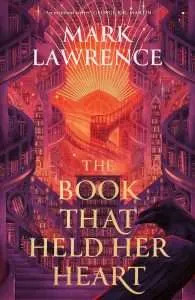 The centerpiece of the Library Trilogy is the Athenaeum, an infinitely large library that, according to legend, was designed and constructed by Irad, the grandson of Cain and great-grandson of Adam and Eve. Irad is embroiled in an age-old battle with his brother, Jaspeth, who vows to destroy the Library to free humanity from the yoke of memory and the corrupting influence of knowledge. The Library becomes a literal and figurative battleground in this epic war between knowledge and ignorance, a battle that began between Irad and Jaspeth but continues with their proxies across every age and land.
The centerpiece of the Library Trilogy is the Athenaeum, an infinitely large library that, according to legend, was designed and constructed by Irad, the grandson of Cain and great-grandson of Adam and Eve. Irad is embroiled in an age-old battle with his brother, Jaspeth, who vows to destroy the Library to free humanity from the yoke of memory and the corrupting influence of knowledge. The Library becomes a literal and figurative battleground in this epic war between knowledge and ignorance, a battle that began between Irad and Jaspeth but continues with their proxies across every age and land.
The two lead protagonists of the Library Trilogy are Livira, a young woman whose fate becomes intertwined with that of the Library, and Evar, a young man who grows up trapped inside the Library and raised, together with his four adopted siblings, by two android-like figures known as the Assistant and the Soldier. While Livira and Evar’s storylines are already well established during the first two volumes of the Library Trilogy, The Book That Held Her Heart opens with a new point-of-view character, Anne Hoffman. Anne is a Jewish girl living under Nazi rule in prewar Germany. She grows up in the peace of her grandfather’s secondhand bookshop, until her sanctuary is pierced by the twin evils of antisemitism and fascism.
Mark Lawrence has taken a major gamble by incorporating a real-world storyline in his fantasy universe, but in a trilogy about book burning, the inclusion of Anne’s perspective seems both natural and timely. Lawrence quotes the German Jewish poet Heinrich Heine, who wrote in his 1820–1821 play Almansor the famous admonition, “Dort, wo man Bücher verbrennt, verbrennt man am Ende auch Menschen,” which translates as, “Where they burn books, they will also ultimately burn people.”
The Book That Held Her Heart deals with some very weighty themes, including dehumanization of “the other,” the double-edged sword of memory, and the inherent danger of knowledge in the absence of wisdom. Mark Lawrence handles all of these themes with depth and nuance.
Fortunately, these heavy themes never bog down the story itself, which maintains a brisk pace throughout. This is a hard balance to pull off, and I marvel at Lawrence’s ability to keep the reader thoroughly engaged and entertained while also delivering a philosophical and emotional gut-punch to his unsuspecting readers.
Mark Lawrence writes with wit and gusto throughout the entirety of the Library Trilogy. His casually subversive epigrams at the beginning of each chapter remain a highlight in The Book That Held Her Heart. I especially enjoyed the quote attributed to Boris, one of my favorite under-the-radar characters from the Lawrencian universe, who debuted (perhaps?) in the brilliant Dispel Illusion. Just as I thought the series couldn’t become more meta, The Book That Held Her Heart even quotes itself.
Although Mark Lawrence is known for his perfectly conceived opening sequences, the Library Trilogy truly shines in its endings. Each book in the Library Trilogy has a shockingly unique ending that left me intellectually and emotionally destroyed in three completely different ways. The ending of The Book That Held Her Heart hits so hard that I feel like the publisher should include a packet of tissues between the last page and back cover.
The Book That Held Her Heart is the perfect conclusion to Mark Lawrence’s most ambitious trilogy to date. Altogether, the Library Trilogy is one of the most profound and wholly original works of fiction that I’ve read in the past two decades. The Library Trilogy should place Mark Lawrence’s name in the same breath as other twenty-first century masters of speculative fiction, including David Mitchell, Haruki Murakami, and the 2017 Nobel Prize winner Kazuo Ishiguro.
Read The Book That Held Her Heart by Mark LawrenceThe post REVIEW: The Book That Held Her Heart by Mark Lawrence appeared first on Grimdark Magazine.
November 2, 2024
REVIEW: The Genesis of Change by Livia J. Elliot
If you’re feeling mentally dialled in and keen for a complex magic system based on learning and the philosophy of cognitive bias, then Livia J. Elliot’s The Genesis of Change is very likely going to hit your dark fantasy sweet spot. In a universe where the select few get to evolve to treat humanity as lab rats, this novella has some interesting and thought-provoking themes delivered by some fascinating non/post-human characters.
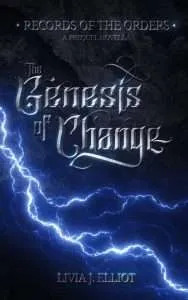 In The Genesis of Change an order of alchemists (magicians / wizard-style characters who transcend humanity) led by the god-like Rector are attempting to further their understanding of their philosophy-based magic system by teaching pupils and studying humans. The Rector engages Elan and Verve, two alchemists, as it is a time for change for the alchemists and The Orders their magic is built upon. Elan’s charge is to teach a human novice named Aurea, and with one mind link she finds a young person looking for revenge. Verve goes to find Iurdan, a healer at a clinic with an odd way of thinking, who the Rector thinks is the key to change.
In The Genesis of Change an order of alchemists (magicians / wizard-style characters who transcend humanity) led by the god-like Rector are attempting to further their understanding of their philosophy-based magic system by teaching pupils and studying humans. The Rector engages Elan and Verve, two alchemists, as it is a time for change for the alchemists and The Orders their magic is built upon. Elan’s charge is to teach a human novice named Aurea, and with one mind link she finds a young person looking for revenge. Verve goes to find Iurdan, a healer at a clinic with an odd way of thinking, who the Rector thinks is the key to change.
The writing style for me was a bit hard to get in to at first. It’s an odd but enjoyable mix of whimsical and scientific in nature as you are brought into this world by an eternal being, have the magic system explained to you by two alchemists who are markedly non-human—a crow and a smoke being thousands of years old—with Aurea’s teachings happening in the past, now, and future, and Verve’s observations of Iurdan occurring across years. I quite liked the style, the more I got into it.
With a cognitive-bias based magic system that is quite complex to wrap your head around, you definitely also need your thinking cap on for this one. The author delves into some relatively deep philosophical questions of the self which are interesting reading—some of which I have to admit I was not of the intellectual level required to realise during the reading, and only understood during the author’s note at the very end.
What will appeal to a grimdark fan is an interesting question with this book. The way it reads, it shouldn’t really appeal at all. It’s somewhat lyrical and high fantasy in taste. But when you break down the flavours within, the way the alchemists treat people as little lab rats to train and mentally break and rebuild Aurea and to push Iurdan to unknowingly reveal his secrets is quite brutal. Through the scope of the alchemists’ points of view it makes sense, and only to us, the human reader, is the horror of what’s happening obvious.
Having said that, I think The Genesis of Change suffers from the prequel short-form curse, in that it doesn’t work tremendously well as a stand alone piece of writing that the casual book buyer could pick up and read without knowledge of the rest of the work and get a complete experience. The two story arcs never really find their way back together to create a climax that I understood. It felt like this needed to be a short novel to allow for a climax to create a clean break and a conclusion for the reader. I imagine The Genesis of Change would create an enjoyable segue into the interactive book Mien (which is just a cool AF method of storytelling) if you were to jump straight from one to the other, or if you had already read and experienced Mien and were coming back to this novella. For me, I just wanted that clear ending to round out my reading experience.
The Genesis of Change by Livia J. Elliot is an enjoyable short read that is really going to get your grey matter churning. If you’re ready to be challenged–and ready to jump straight into the following novel so it becomes one cohesive reading experience–then I’d grab this one and give it a go.
Read The Genesis of Change by Livia J. ElliotThe post REVIEW: The Genesis of Change by Livia J. Elliot appeared first on Grimdark Magazine.
November 1, 2024
REVIEW: The Narrows by Ronald Malfi
Ronald Malfi delivers vampiric horror without vampires in The Narrows, an Appalachian Gothic thriller originally published in 2012. The novel has just been re-released as an Author’s Preferred Edition, including a brand-new introduction from the author and a prologue that had never been included in any print version of the book until now. I had the pleasure of reading the signed Broken Binding version of the novel, which features a blood-red sprayed edge that only enhances the gruesome nature of the story.
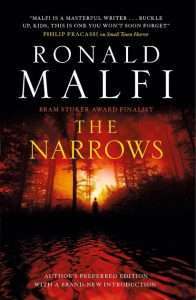 Ronald Malfi takes inspiration from classic vampire fiction, paying special homage to Bram Stoker’s Dracula, while taking The Narrows in a completely unconventional direction for this subgenre of horror. The author’s creativity is on full display as he imagines something even more horrific that could prove foundational for vampiric legends.
Ronald Malfi takes inspiration from classic vampire fiction, paying special homage to Bram Stoker’s Dracula, while taking The Narrows in a completely unconventional direction for this subgenre of horror. The author’s creativity is on full display as he imagines something even more horrific that could prove foundational for vampiric legends.
The Narrows takes place in a small fictional town of Stillwater located in the mountains of western Maryland. Rural Appalachia proves to be the perfect setting for creating a feeling of isolation while showing the impact of an unknown horror on ordinary small-town families.
The suspense builds steadily throughout The Narrows, starting with a strange bat infestation and escalating to a mysterious automobile accident and cattle mutilation. The plot ultimately builds to some genuinely horrifying scenes, which increase in intensity in the latter part of the book. There is a healthy dose of body horror, so readers should be forewarned if that type of content makes you feel squeamish. For me personally, all I will say is that the book’s climax did nothing to alleviate my borderline case of chiroptophobia.
Altogether, The Narrows succeeds in bringing an entirely new spin on the classic vampire trope. Ronald Malfi’s prose burns with the same intensity as the story he tells. Although the ending of The Narrows made my stomach churn, I was also left with an ineffable desire to dive directly into the rest of Malfi’s back catalog.
Read The Narrows by Ronald MalfiThe post REVIEW: The Narrows by Ronald Malfi appeared first on Grimdark Magazine.
October 31, 2024
Grimdark Magazine acquires world rights to Richard Swan’s first Vonvalt prequel novella
Last Updated on November 1, 2024
If you loved Richard Swan‘s Empire of the Wolf trilogy, then I hope you’re as excited as I am to announce we have acquired the worldwide print, digital, and audio rights for the first ever prequel novella in that world featuring Vonvalt and Bressinger. The Justice of Kings, The Tyranny of Faith, and The Trials of Empire were three of my favourite books of the decade so far, and with news of the Grave Empire acquisition by Orbit, we know there is plenty more of this world to see.

We asked Richard about why he wanted to return to Vonvalt’s story:
“For me and I think many fans of the series, reading about Vonvalt investigating crimes and prosecuting criminals was the highlight of the trilogy. The opportunity to return to the world of the Empire of the Wolf, this time fifteen years before the events of The Justice of Kings, and throw Vonvalt and Bressinger back into a dark fantasy police procedural (with a sprinkling of mystery and horror for good measure) was too good to pass up. I’m really excited to partner with Grimdark Magazine to get the first of these novellas out into the world in October 2025!”
We’re all really looking forward to releasing more detail in the lead up to the expected publication in October 2025. I think this is going to be a really special project.
More to comeTo keep track of this and other news in Grimdark Magazine publishing, please join our mailing list for monthly newsletters providing insights into the world of dark SFF across books, screen, and video games, and other news and updates. You’ll also get a free magazine issue with featuring a short story set in Swan’s The Art of War space opera universe!
ReviewersReviewers (review websites, Booktubers, Booktokkers, etc) interested in signing up for an ARC of this book, please complete our publicity form, here. We will be doing a very limited run of print copies, and will also have ePub copies.
The post Grimdark Magazine acquires world rights to Richard Swan’s first Vonvalt prequel novella appeared first on Grimdark Magazine.
October 30, 2024
Putting the Fangs into Fantasy: Why I Wrote my Book
In just three months as I write this, Lightfall, the first book in my epic fantasy trilogy The Everlands, will be loosed onto the world—I hope you like terrible jokes in your chapter headings, fantasy fans—and a question I’m sometimes asked is the following: why vampires and werewolves in fantasy?
The simple answer is that it sounds awesome, but the esteemed and depraved souls at Grimdark Magazine probably want an article not a paragraph, so I looked deep into myself (always an unwise move) and I came up with Terry Pratchett.
More specifically, Pratchett’s 24th Discworld book, The Fifth Elephant, which I’ll come back to.
But first, let’s check in with ten-year-old me, who is staying up late with his dad to watch one of his first 18-rated horror films, An Interview with the Vampire (dobbing my dad in but that’s fine, he won’t read this). Obviously it traumatised me and gave me nightmares (a fine foundation for any adult horror obsessive) but it put me firmly on the vampire bandwagon. Around the same time, I read The Lord of the Rings and A Wizard of Earthsea (yes, I was a precocious ten-year-old, yes you would have loathed me, yes you would have been correct).
So there I am, aged ten and already split hopelessly between horror and fantasy for life. Pity my future wallet. I am Legend and Salem’s Lot would solidify my vampire love, while all the usual SFF names of the late 90s and 2000s (dear Christ, us millennials are getting old) kept my teenage self on the fantasy path.
Now we return to The Fifth Elephant, which I read on release (do you remember how exciting a Discworld release was? Dopamine hits have never been the same). If you haven’t read it, stop reading this and immediately devour the City Watch sub-series of Discworld (in order, you maniac). In case you haven’t done that, let me terribly summarise: it features Vimes, the chief of police of a fantasy city, travelling to a nearby rural country called Uberwald, which is where the vampires or werewolves live. At first there as an ambassador, he soon discovers a conspiracy that could drive the region into war.
While there are some scary scenes—a tense bit where the eponymous Vimes is hunted by werewolves through the land and must outwit them is so good I completely cribbed it for my more werewolf-heavy Book 2 of my series, originality not being my strong suit—it’s the vampire and werewolf politics that grabbed me. The idea of a region where they co-exist and scheme against each other and other countries? Ever since then, I’ve not stopped thinking about it.

Ed Crocker, Image Credit to Julia Boggio
So much so that when I was a 27-year-old teacher and thoroughly hating my life (standard teacher mood) I recalled my desire to pick up on that idea and started writing the first book in a planned five-book saga on vampires, werewolves, sorcerers and, uh, nihilistic banshees (Actually, I abruptly quit my job first with no money in the bank, but that’s an entirely different story for a magazine called Stupid Young People Make Curious Decisions that Luckily Turn out Pretty Well.)
That series got zero interest—I’m still fond of it, and I miss my gloriously bizarre take on banshees, but some/all scenes have not aged well—so I wrote another book with vampires, werewolves and sorcerers in, and another… you get the point, which is that I’m a stubborn so-and-so who’s only ever had one idea. A decade after my offensively maverick “quit my job to be a novelist” decision, I finally get to force that idea onto the world whether it wants it or not.
But still the question remains: what is it about horror tropes that works well in fantasy? Well let me focus on vampires, who steal the show more than my werewolves, in Book 1 at least. For me there’s a lot of answers to that question, but two of the best are blood and immortality.
Let’s take blood first. Whether it’s seductive bloodsuckers putting the ro-mance into e-mancipating you from your life (if you liked that bomb of a joke, you’re going to love my book) or the kind of horrifically terrifying freaks from the graphic novel (and Josh Hartnett film triumph) 30 Days of Night, the timeless power of blood is arguably what gives the vampire legend its remarkable cultural staying power.
Blood is life, obviously, but blood is also sensuality, the dichotomy of pain and pleasure. What is a vampire romance if not an S&M bondage fest? As one of my characters remarks, though it is always painful to bleed, it is not always bad. Blood contains our soul in some readings; our very life essence. It carries disease, but it also saves. Vampires take your blood, but they give the dubious gift of eternity.
In my series, one of the angles by which I examine blood is the analogy of the poverty trap. In my vampire city, the poor get the weakest blood—I won’t go into too much detail, as the poor editor of this article is already smacking their head against the screen at the wordcount—and the rich get the best blood. So if you’re rich, you are strong and mentally sharp, and you never age. If you’re poor, you’re weak in both body and mind, and you die after a couple of centuries.
Often in our own society we are fooled by the idea we can “pull ourselves up by our bootstraps” to improve our lives. But if the very blood you drink (cough: diet, stress levels, exercise, sleep quality) is harming you through no fault of your own but the situation of your birth, how can you ever hope to fulfil this fairytale idea of class emancipation? Through such ideas can horror tropes exist in a complex political fantasy.
Then there’s the second reason I’m fascinated by the horror classics: immortality. I am obsessed by the idea of how a society would look if many of its denizens are centuries old. How does an economy or political ecosystem change if people have such long memories—and long-held grudges and hatreds? How is your personality affected by losing someone three centuries ago and having to face a near eternity of grief? Grief, as many of you will sadly know, never gets better. It just gets less frequent, but it still hits as hard, and knocks the wind right out of you until you remember how to breathe again, and, maybe, one day, be happy.
I’m not sure eternity is worth that, and neither are some of my characters.
So there we have it. Epic fantasy and the hammer horror classics might not be that frequent bedfellows, but there’s a world of intrigue to be had when they do get together.
And if not, I’ll just bring my nihilistic banshees back again.
Read Lightfall by Ed Crocker
The post Putting the Fangs into Fantasy: Why I Wrote my Book appeared first on Grimdark Magazine.
October 29, 2024
REVIEW: The Nightmarchers by J. Lincoln Fenn
There’s something about J. Lincoln Fenn’s thriller-horror novel The Nightmarchers that I can’t stop thinking about. The pacing of this book races at mach speed. The unsettling horror creeps up to you slowly, ever so slowly, before showing itself in the light. The protagonist is one I would follow to the ends of the earth (or at least to a mysterious island) and back.
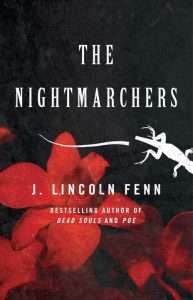 The Nightmarchers begins with Julia Greer, a struggling journalist trying to survive a costly divorce and see her child. Her estranged great-aunt Lydia promises her a great sum of money if she travels to Kapu, a mysterious island that is run as a tropical resort by a religious group. She’s to retrieve the body of Lydia’s long lost sister Irene, who died on Kapu while conducting experiments in the 1930s. Julia has no choice but to accept. I found Julia to be instantly sympathetic, and rooting for her came easily, especially when we see how her ex-husband treated her.
The Nightmarchers begins with Julia Greer, a struggling journalist trying to survive a costly divorce and see her child. Her estranged great-aunt Lydia promises her a great sum of money if she travels to Kapu, a mysterious island that is run as a tropical resort by a religious group. She’s to retrieve the body of Lydia’s long lost sister Irene, who died on Kapu while conducting experiments in the 1930s. Julia has no choice but to accept. I found Julia to be instantly sympathetic, and rooting for her came easily, especially when we see how her ex-husband treated her.
Julia’s arrival on Kapu kickstarts her journey to discovering the truth of her family. Irene’s death in the 30s was mysterious, and Julia is on a mission to discover what actually happened. The other tourists on the island, as well as the Church of the Eternal Light that play as her hosts, are already suspects in a game that Julia unknowingly plays. I was left wondering who was on Julia’s side, and who was there to sabotage her mission. It certainly adds to the horror when you can’t really know who it is you can turn to.
Fenn’s writing carried me through The Nightmarchers at a lightning pace. I didn’t want to put this thing down, not until I hit the end. It slows at important, information-heavy moments, then ramps up at unexpected moments. The horror and suspense sings when Julia encounters some of the more supernatural elements of the island.
The Nightmarchers does one of my favorite things in horror: teasing the scares all throughout the novel, only to unleash it when the reader least expects it. I felt uneasy during the story, but that only made me turn the pages faster. Pair that with a group of characters that are constantly scheming and hiding their true intentions, and you’ve got a book that will keep you reading all through the night.
Even writing this review, I still wonder what it is about this book that won’t let go of me. The Nightmarchers seems to have entered into my mind and won’t leave, and I’m honestly okay with that. The world that Fenn created fascinates me, and I find myself rereading sections of the novel to relive the narrative.
The Nightmarchers is well worth anyone’s time, especially those who like their horror mixed with the thriller genre. It felt like a short read, but that may be because of the fast paced narrative. This is a book I’m going to be thinking about for a good long while.
Read The Nightmarchers by J. Lincoln FennThe post REVIEW: The Nightmarchers by J. Lincoln Fenn appeared first on Grimdark Magazine.

